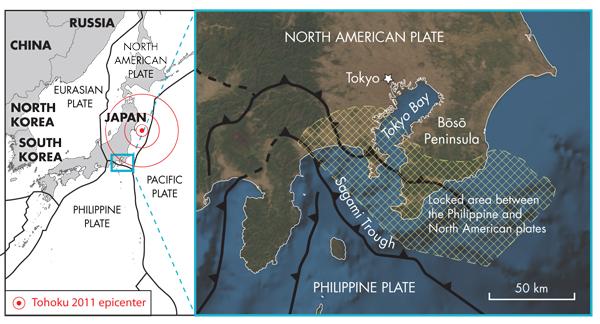Tokyo is a city of more than 13 million people and they are no strangers to earthquakes. The city, like much of Japan, has been devastated by earthquakes in the past and likely will be again - but when?
Ongoing slow-slip earthquakes can't usually be felt at the surface but they play a role in relieving or building up geological stress and recent research examining plate movements under Tokyo has found that, since the massive magnitude-9 Tohoku earthquake and tsunami in March 2011, recurrence intervals for non-damaging slow-slip quakes beneath Japan's capital have shortened.
This has led some seismologists to wonder if this aseismic creep could be signaling a countdown to Tokyo's next "big one."
Between Dec. 28, 2013, and Jan. 10, 2014, GPS sensors detected a 10-centimeter shift between the two plates over the two-week period — that’s equivalent to the energy released by a magnitude-6.5 earthquake.

Japan sits at the intersection of multiple tectonic plates. Just east of the island is a deep trench called the Sagami Trough. To monitor slow slip in the region, scientists are tracking the surface motion of the Boso Peninsula on the eastern side of Tokyo Bay, where the Philippine Plate plunges beneath the Eurasian Plate, creating the trough. Credit: Kathleen Cantner, AGI, after Ozawa et al., Geophysical Research Letters (2014),
DOI: 10.1002/2014GL060072.
The slip comes a little more than two years after the Bōsō’s last aseismic event, a month-long slip in October and November 2011. This recurrence interval is getting shorter, decreasing from 6.4 years in 1996 to 4.2 years in 2011, says Shinzaburo Ozawa of the Geospatial Information Authority of Japan in Tsukuba.
The estimated moment magnitudes for the slow-slip events have remained relatively consistent: 6.7 in 2011, 6.6 in 2007, 6.6 in 2002 and 6.6 in 1996. Records of Bōsō’s slow slip only extend back to 1996 when GPS monitors were installed; seismographs do not record slow slip, which generally does not cause any damage, Ozawa says.
Is there concern? Ozawa isn’t ready to declare Tokyo under threat. “At present, we cannot say this [shortening interval] is a warning signal of a coming earthquake,” he told EARTH roving correspondent Mary C. Morton.





Comments